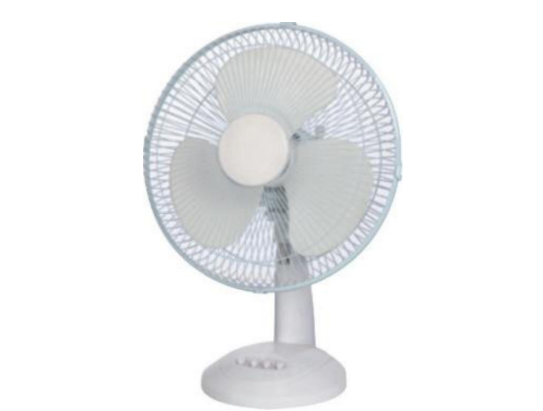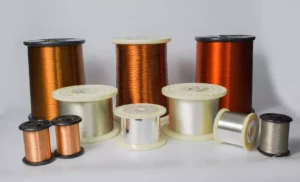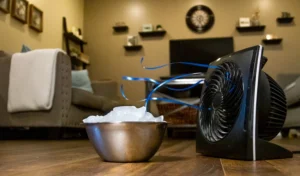A small room can feel hot and stuffy.
Big, bulky fans only make the space feel more cramped.
The right compact fan provides powerful cooling without taking up precious floor space.
The best fans for small spaces are tower fans, wall-mounted fans, and compact desk or table fans.
These types are designed to save space while providing effective, targeted airflow, making them perfect for bedrooms, offices, dorm rooms, and apartments.
Choosing the perfect fan can feel overwhelming with so many options available.
This guide will break down everything you need to know, from the different types of fans to the key features that matter most.
We’ll help you find the ideal cooling solution to make your small space comfortable and clutter-free.
What Fan Types Work Best in Small Rooms?
Feeling the heat in your cozy apartment or dorm room?
A bulky fan is the last thing you need.
Let’s explore which fan types are specifically designed to maximize comfort in tight quarters.
The most effective fans for small rooms are those with a minimal footprint, such as slim tower fans, versatile table fans, or space-saving wall-mounted fans.
These models deliver direct or oscillating airflow to keep you cool without becoming an obstacle in your living area.
When you have limited floor space, every square inch counts.
Traditional pedestal fans can be awkward and take up valuable room, while some floor fans are too powerful for a small area.
The goal is to find a fan that integrates seamlessly into your space, providing a cooling breeze exactly where you need it.
Let’s look at the top contenders for compact living.
Tower Fans
Tower fans are tall, slim, and designed to fit perfectly in tight corners or small nooks.
Their vertical design takes up very little floor space, which is a huge advantage in rooms like dorms, home offices, or small bedrooms.
Most tower fans oscillate, meaning they turn from side to side to distribute air across a wider area.
This feature is great for cooling more than one person or for circulating air throughout the entire room.
Many models also come with convenient features like remote controls and multiple speed settings, allowing you to adjust the airflow from your bed or desk.
Their design is often modern and sleek, helping them blend into your home decor more easily than a traditional round fan.
Because they move air through a vertical column, they provide a gentle, consistent breeze rather than a harsh gust, making them a comfortable choice for long periods of use.
Table and Desk Fans
Table fans, also called desk fans, are the classic solution for personal cooling.
These fans are small, portable, and perfect for placing on a nightstand, desk, or countertop to provide a focused stream of air.
They are excellent for creating a direct breeze while you work, study, or sleep.
Their small size makes them easy to move from one room to another as needed.
While they are smaller than other types, a good table fan can still deliver powerful airflow.
Many models feature adjustable heads that can be tilted up or down, giving you precise control over the direction of the breeze.
Some even offer an oscillation feature to cool a slightly larger area.
They are a great choice when you need targeted cooling for one or two people in a specific spot, like a home office or a kitchen prep area.
Wall-Mounted Fans
When floor and table space are both at a premium, a wall-mounted fan is a game-changer.
As the name suggests, these fans are installed directly onto a wall, freeing up all your surfaces and floor area.
This makes them ideal for small kitchens, workshops, or bedrooms where you need airflow without any clutter.
Wall fans provide excellent air circulation from an elevated position, helping to move air throughout the entire room.
They almost always come with oscillation settings and adjustable tilt angles, allowing you to direct the airflow down into the living space effectively.
Because they are out of the way, they are also a safer option in homes with pets or small children.
Many modern wall fans can be operated with a remote control, making it easy to adjust settings without having to reach up.
Key Features to Look for in a Compact Fan
Your small room feels stuffy, but you worry a fan will be too loud or ugly.
A fan should solve problems, not create new ones.
Let’s find a fan that is quiet, portable, and stylish.
The key features for a small-space fan are a compact and portable design, low noise levels for quiet operation, and an aesthetic that complements your decor.
Look for a lightweight fan that is easy to move and operates at a low decibel (dB) rating.
When buying a fan for a small space, the details matter.
It’s not just about moving air; it’s about improving your comfort without disrupting your environment.
A fan that is easy to carry from your desk to your bedside table adds a layer of convenience.
A quiet motor ensures you can concentrate on work or get a peaceful night’s sleep.
And since it will be a visible part of your room, it should look good, too.
Let’s examine these essential features more closely to help you make the best choice.
Size and Portability
For small spaces, the fan’s physical size is a primary concern.
You need a unit that can fit on a small table, a tight corner, or a crowded desk without getting in the way.
Look for fans with a compact design and a stable base that prevents them from tipping over easily.
Portability is just as important.
A lightweight fan is easy to move from your living room during the day to your bedroom at night.
Some models are even designed to be cordless and rechargeable, offering the ultimate flexibility for use on a balcony or during a power outage.
The ability to easily bring a fan indoors is also helpful if you use it in a sheltered outdoor space like a balcony and the weather suddenly turns.
Noise Level (Decibels)
Peace and quiet are essential, especially in a small home where sound can travel easily.
A loud fan can be distracting when you’re trying to work, read, or sleep.
Fan noise is measured in decibels (dB).
For reference, a soft whisper is about 30 dB, while a normal conversation is around 60 dB.
For bedrooms and offices, look for fans with a decibel rating below 60 dB, and ideally under 40 dB on their lowest settings.
Many manufacturers list the dB rating for their products, so it’s a good number to check before you buy.
Table fans and personal fans tend to be quieter than larger models, often running at around 35-48 dB.
| Sound Source | Approximate Decibel (dB) Level |
| Whisper | 30 dB |
| Quiet Fan | 35-45 dB |
| Refrigerator Hum | 40 dB |
| Normal Conversation | 60 dB |
Build Quality and Aesthetics
A fan is also a piece of decor.
It should complement the style of your room, not clash with it.
Fans are available in a wide variety of designs, materials, and colors.
You can find models with metallic finishes for an industrial look, bamboo or wood accents for a natural vibe, or bright colors to add a fun pop to your space.
Beyond looks, consider the build quality.
A fan made from durable materials like metal or high-grade ABS plastic will last longer and be more stable.
A sturdy base is crucial to prevent wobbling, especially for taller tower fans or table fans placed on uneven surfaces.
Understanding Airflow: CFM and RPM Explained
You see terms like CFM and RPM, but what do they actually mean for your small room?
Choosing a fan based on confusing specs can lead to weak airflow.
Let’s decode these terms for better cooling.
CFM measures the volume of air a fan moves, while RPM measures its blade speed.
For a small space, you don’t need the highest numbers; you need the right balance for efficient and comfortable air circulation.
To pick the right fan, it helps to understand the numbers that measure its performance.
The two most important metrics are CFM (Cubic Feet per Minute) and RPM (Rotations Per Minute).
These figures tell you how powerful a fan is and how much air it can circulate.
While a huge industrial fan might boast a CFM in the thousands, that kind of power is unnecessary for a small bedroom or office.
Understanding what these ratings mean will help you choose a fan that is effective but not overpowering.
What is CFM?
CFM stands for Cubic Feet per Minute.
It is a measurement of the volume of air that a fan can move in one minute.
A higher CFM number means the fan moves more air, making it more powerful.
For example, a small personal fan might have a CFM of around 100, while a heavy-duty garage fan can exceed 3,000 CFM.
For most standard-sized fans used in homes—including tower, table, and floor models—the CFM typically ranges from about 300 to 600, depending on the speed setting.
In a small room, a fan in the lower end of this range is often more than sufficient to create a comfortable wind-chill effect without feeling like a wind tunnel.
What is RPM?
RPM stands for Rotations Per Minute.
This number tells you how fast the fan’s blades are spinning.
A higher RPM generally contributes to higher air delivery because the blades are moving faster to push more air.
For table fans, an effective RPM is typically between 1300 and 2100.
For example, some compact table fans can deliver strong, consistent airflow with motors running at 1300 or 1400 RPM.
While RPM is a good indicator of motor speed, CFM is the more direct measurement of how much cooling you’ll actually feel.
A fan with well-designed blades can move a lot of air (high CFM) without needing an extremely fast motor (high RPM), which also helps keep noise levels down.
Finding the Right Balance
For a small space, the goal isn’t to find the fan with the highest possible CFM and RPM.
Instead, you want a balance.
A fan with extremely high airflow can be noisy and create uncomfortable drafts.
Look for a fan that provides enough CFM to circulate air effectively in your room’s square footage.
Multiple speed settings are a key feature here, as they allow you to adjust the airflow to your needs.
You can use a lower, quieter speed for gentle circulation while you sleep and a higher speed for quick cooling on a hot afternoon.
Do Bladeless Fans Save Space?
You want a modern, safe fan, but are bladeless models just a gimmick?
Their high price can be a turn-off if they don’t deliver.
Let’s see if their unique design is a true space-saver.
Bladeless fans can be very space-efficient, often featuring slim pedestal or tabletop designs that fit well in small rooms.
Their main advantage is a futuristic look, safety, and ease of cleaning, which makes them an attractive option for modern, compact interiors.
Bladeless fans have become a symbol of modern design and innovative technology.
Instead of traditional spinning blades, they use a completely different method to generate a smooth, consistent stream of air.
Air is drawn into the base of the fan and then pushed out through a narrow slit in a loop or ring.
This process multiplies the airflow, creating a cooling breeze without any visible moving parts.
This technology not only looks futuristic but also offers practical benefits, particularly for those living in smaller homes or apartments.
Their design is one of their biggest selling points.
Many bladeless fans come in sleek, slender forms that resemble sculptures more than appliances.
This allows them to blend seamlessly into a modern home’s decor.
They are available in various sizes, including tall, thin pedestal models that take up minimal floor space and compact tabletop versions perfect for a desk or counter.
The absence of blades also means there are no grilles or cages to collect dust, making them exceptionally easy to wipe clean.
This is a significant advantage for maintaining air quality and reducing allergens in a small space.
For households with children or pets, the lack of accessible spinning blades is a major safety feature.
You don’t have to worry about curious fingers or paws getting injured.
In terms of performance, they provide a steady, uninterrupted stream of air, which can feel more pleasant than the buffeting airflow from some bladed fans.
Many models also include advanced features like remote controls, multiple speed settings, and oscillation to distribute air throughout the room.
Some even combine cooling with other functions, like misting, to provide extra relief on hot days.
While they can be more expensive than traditional fans, their combination of style, safety, and space-conscious design makes them a compelling choice for anyone looking to cool a small space without clutter.
Smart Placement: Where to Put Your Fan for Max Cooling
You bought the perfect fan, but your room still feels warm.
Placing a fan in the wrong spot can just push hot air around.
Let’s learn how to position it for the best cooling effect.
For maximum cooling, place your fan strategically to create cross-ventilation.
Position it opposite a window to circulate cool air inward or near an AC unit to help distribute cold air more effectively throughout the room.
Where you place your fan can make a huge difference in its effectiveness.
Simply putting it in the middle of the room isn’t always the best strategy.
The goal is to create a pattern of air circulation that moves stale, hot air out and brings cooler, fresher air in.
By using your fan smartly, you can enhance its cooling power and make your entire space feel more comfortable.
Different rooms have different needs, so let’s look at the best placement strategies for common small spaces.
In the Living Room
In a living room or seating area, position the fan high on a side wall if it’s a wall-mounted model, or on a stand in a corner if it’s a tower or pedestal fan.
Aim the airflow to circulate across the main seating zone, but avoid pointing it directly at people, which can be uncomfortable.
Bouncing the air off a wall can create a gentler, more widespread breeze.
The fan should be at least 7 feet off the ground if mounted to ensure optimal circulation.
In the Bedroom
For a good night’s sleep, quiet operation and gentle airflow are key.
Place the fan opposite a window or near your air conditioning unit.
This helps either draw in cool nighttime air from outside or distribute the cold air from the AC more evenly.
A fan with a timer is also a great feature for a bedroom, as you can set it to turn off automatically after you’ve fallen asleep.
Choose a model known for being quiet to avoid disrupting your sleep.
In the Kitchen
Kitchens can get hot and stuffy from cooking.
A fan can help expel heat and get rid of odors.
The best place for a fan in the kitchen is near a window or an entryway.
An oscillating fan is particularly useful here, as it can sweep air across both the meal prep area and a small dining nook.
A compact table fan on a countertop or a wall-mounted fan can provide relief without getting in the way of your cooking.
In a Home Office or Workspace
In a home office or studio, a fan can help you stay cool and focused.
Desk fans are perfect for providing a direct, personal breeze.
To improve overall air quality, try placing a fan in a “dead corner” or an alcove.
This helps to “pull” fresh air into parts of the room that might otherwise feel under-ventilated, keeping the entire space feeling fresh.
Conclusion
Choosing the right fan for your small space is simple.
Focus on space-saving types like tower or wall fans, prioritize quiet operation, and place it smartly to maximize airflow and beat the heat.
FAQs
1. What is a good CFM for a small room fan?
A CFM between 200-400 is typically sufficient for a small room. This provides enough airflow for personal cooling and circulation without being overpowering.
2. Is a tower fan or table fan better for a small bedroom?
A tower fan is often better for circulating air throughout the entire room, while a table fan is perfect for providing a direct, personal breeze on a nightstand.
3. Do fans actually cool the air in a room?
Fans do not lower the room’s temperature but create a “wind-chill” effect by circulating air. This helps sweat evaporate from your skin, making you feel cooler.
4. How can I make my small fan more effective?
Place your fan near an open window at night to pull in cooler air. You can also place a bowl of ice in front of it for a temporary mist of cool air.
5. Are bladeless fans significantly quieter than traditional fans?
Not always. While they produce a smooth airflow, the motor in the base can still generate noise. Look for the decibel (dB) rating on any fan to be sure.
6. How much electricity does a small fan use?
Most small table and personal fans are very energy-efficient, typically consuming only 40 to 70 watts of power, much less than an air conditioner.







